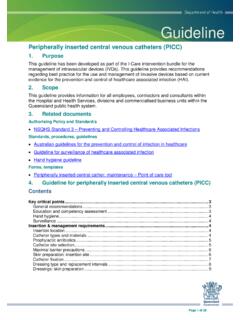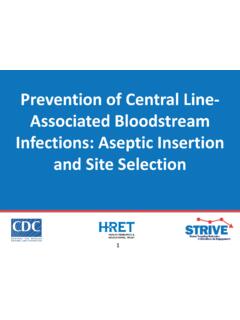Transcription of The Burden of Health Care-Associated Infection Worldwide A ...
1 All reasonable precautions have been taken by the World Health Organization to verify the information contained in this document. However, the published material is being distrib-uted without warranty of any kind, either expressed or implied. The responsibility for the interpretation and use of the material lies with the reader. In no event shall the World Health Organization be liable for damages arising from its acknowledges the H pitaux Universitaires de Gen ve (HUG), in particular the members of the Infection Control Programme, for their active participation in developing this Burden of Health Care-Associated Infection Worldwide A SummaryIntroduction Health Care-Associated Infection (HCAI), also referred to as nosocomial or hospital Infection , is defined as: An Infection occurring in a patient during the process of care in a Health -care facility which was not present or incubating at the time of admission.
2 This includes infections acquired in the hospital but appearing after discharge, and also occupational infections among staff. HCAI is acknowledged as the most frequent adverse event in Health care, but the global Burden remains unknown because of the difficulty of gathering reliable data. This is mainly due to the complexity and lack of uniformity of diagnostic criteria and to the fact that surveillance systems for HCAI are virtually nonexistent in most countries. In many settings, from hospitals to ambulatory and long-term care, HCAI appears to be a hidden, cross-cutting problem that no institution or country can claim to have solved of HCAI worldwideAccording to a literature review of national or multicentre studies published from 1995 to 2008, the overall prevalence of HCAI in developed countries varies between and (Figure 1) and approximately the same proportion of hospitalized patients acquire at least one HCAI.
3 The European Centre for Disease Prevention and Control reported an average prevalence of in European countries and estimated that 4 131 000 patients are affected by approximately 4 544 100 episodes of HCAI every year in Europe. The estimated HCAI incidence rate in the United States was in 2002, corresponding to infections per 1 000 patient-days and million affected patients. According to a recent European multicentre study, the proportion of infected patients in intensive care units can be as high as 51%; the majority of these are HCAI and the risk of Infection increases with duration of stay in intensive care. While HCAI surveillance systems are in place at national/sub-national level in many developed countries, only 23 developing countries (23/147 [ ]) reported a functioning national surveillance system in a survey conducted by the WHO First Global Patient Safety Challenge.
4 Therefore, very scanty data are available from the vast majority of low- and middle-income countries. Only nine published studies reported HCAI data at national level. Studies conducted in Health -care settings in developing countries report hospital-wide HCAI rates markedly higher than those in developed countries. Hospital-wide prevalence rates vary from 5% to 19%, but most studies report values higher than 10% (Figure 2).The Burden of HCAI is also much more severe in high-risk populations, such as adults housed in critical care and neonates, with overall Infection rates and device- associated Infection rates several-fold higher than in developed countries. The incidence of Infection acquired in critical care in developing countries is at least twice that of the United States.
5 In particular for some device- associated infections ( , bloodstream Infection and ventilator- associated pneumonia), incidence densities can be up to 19 times higher than in developed countries. Neonatal Infection rates in developing countries are 3-20 times higher than in industrialized countries. Comparisons of device- associated Infection rates in adult and paediatric ICUs reported from the United States and multicentre studies in developing countries are shown in Table 1. Surgical site Infection (SSI) represents the most surveyed and most frequent type of Infection in developing countries. According to the literature, the incidence of SSI ranges from to per 100 surgical procedures. This level of risk is significantly higher than in developed countries where SSI rates average around 2-3%.
6 Although HCAI global estimates are not yet available, by integrating the data reported above from studies conducted in both developed and developing countries, it is clear that hundreds of millions of patients are affected by HCAI every year around the world and that the Burden of disease in low- and middle-income countries is much higher than in developed of HCAIA ccording to the available evidence, the impact of HCAI implies prolonged hospital stay, long-term disability, increased resistance of microorganisms to antimicrobials, massive additional financial Burden for Health systems, high costs for patients and their family, and unnecessary deaths. In Europe, HCAIs cause 16 million extra days of hospital stay and 37 000 attributable deaths, and contribute to an additional 110 000, every year.
7 The Burden of disease is also reflected in significant annual financial losses estimated at approximately 7 billion, including direct costs only. In the United States, approximately 99 000 deaths were attributed to HCAI in 2002 and the annual economic impact was approximately US$ billion in 2004. Some infections, such as bloodstream Infection and ventilator- associated pneumonia, have a more severe impact than others in terms of mortality and extra costs. For instance, the mortality rate directly All reasonable precautions have been taken by the World Health Organization to verify the information contained in this document. However, the published material is being distrib-uted without warranty of any kind, either expressed or implied.
8 The responsibility for the interpretation and use of the material lies with the reader. In no event shall the World Health Organization be liable for damages arising from its acknowledges the H pitaux Universitaires de Gen ve (HUG), in particular the members of the Infection Control Programme, for their active participation in developing this : : & Ireland: **: : : **: : : : : : 1 Prevalence of HCAI in developed countries** Systematic review conducted by WHO, 1995-2008 **Incidenceattributable to bloodstream Infection in critically ill patients has been estimated to be 16 40% and the increase in length of stay between 25 days. Nosocomial bloodstream infections are estimated to account for 250 000 episodes every year in the United States and cases due to antibiotic-resistant organisms in particular have increased over the last few studies from developing countries assessed HCAI impact and no report provided national estimates.
9 Increased length of stay associated with HCAI varies between 6 and 23 days in non-critically ill patients. In developing countries, crude excess mortality in adult critically ill adults affected by ventilator- associated pneumonia is reported to be as high as Among hospital-born babies in developing countries, HCAI are responsible for 4% to 56% of all causes of death in the neonatal period, with 75% occurring in South-East Asia and Sub-Saharan Africa. Costs attributable to HCAI are poorly and variably reported in low- and middle-income countries. For example, the economic Burden of HAI in Belo Horizonte, Brazil, was estimated to be equal to US$ 18 million in 1992. In Mexican ICUs, the overall cost of a HAI episode was US$ 12 155 with an excess cost of US$ 11 591 per case of catheter-related bloodstream Infection .
10 In several ICUs in Argentina, the overall extra-cost estimates for catheter-related bloodstream Infection and Health Care-Associated pneumonia averaged US$ 4 888 and US$ 2 255 per case, : : : : : : : : : : : %Tanzania: 2 Prevalence of HCAI in developing countries** Systematic review conducted by WHO, 1995-2008 All reasonable precautions have been taken by the World Health Organization to verify the information contained in this document. However, the published material is being distrib-uted without warranty of any kind, either expressed or implied. The responsibility for the interpretation and use of the material lies with the reader. In no event shall the World Health Organization be liable for damages arising from its acknowledges the H pitaux Universitaires de Gen ve (HUG), in particular the members of the Infection Control Programme, for their active participation in developing this material.
















